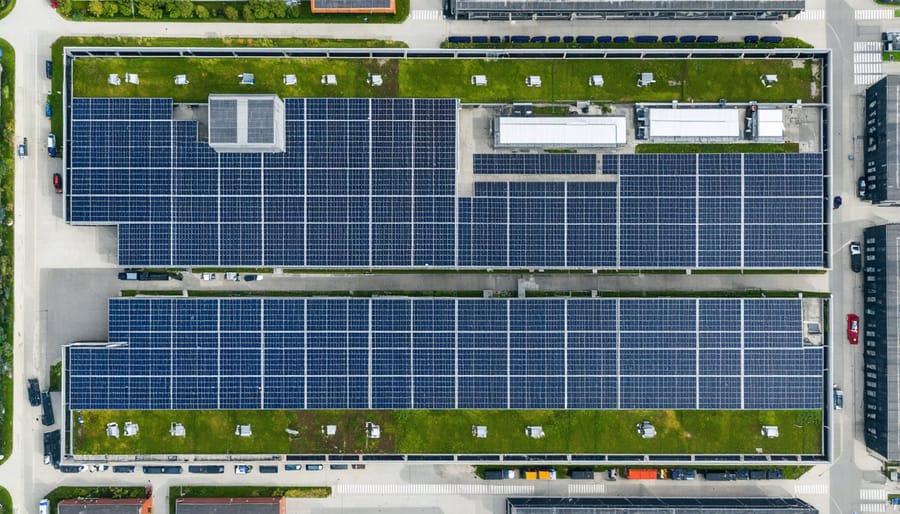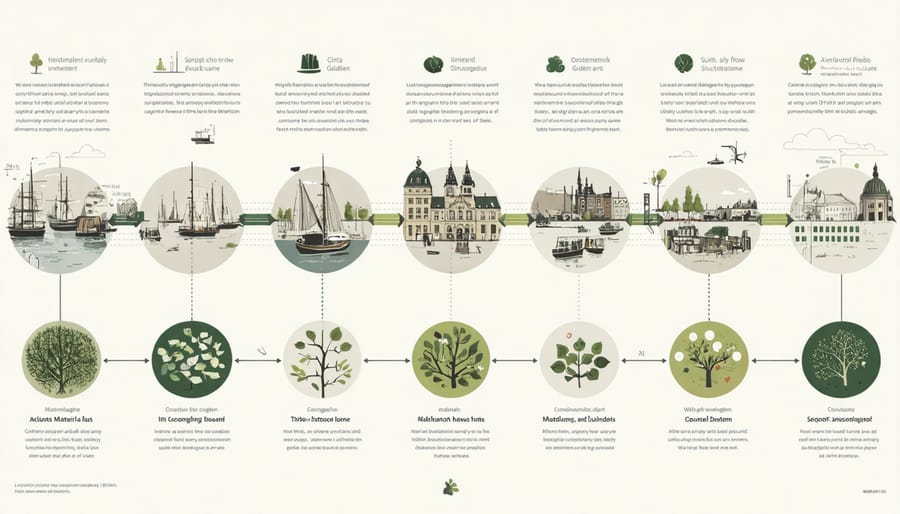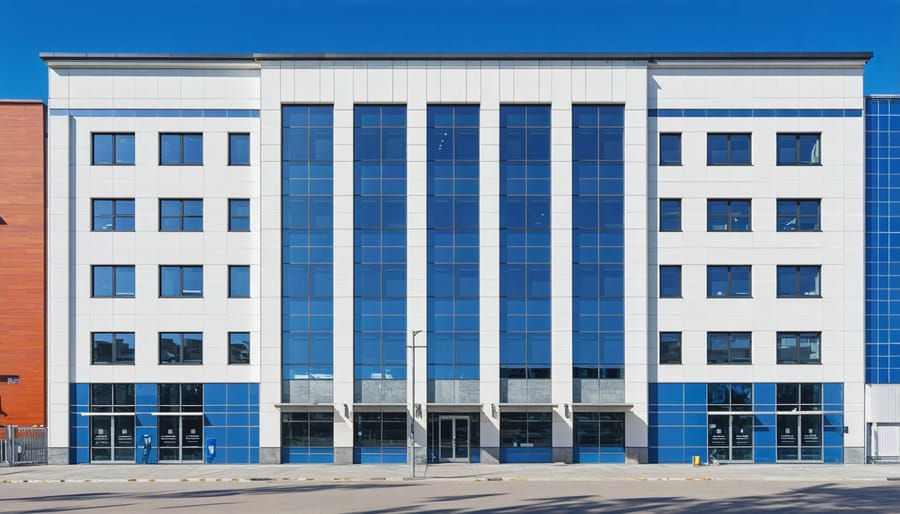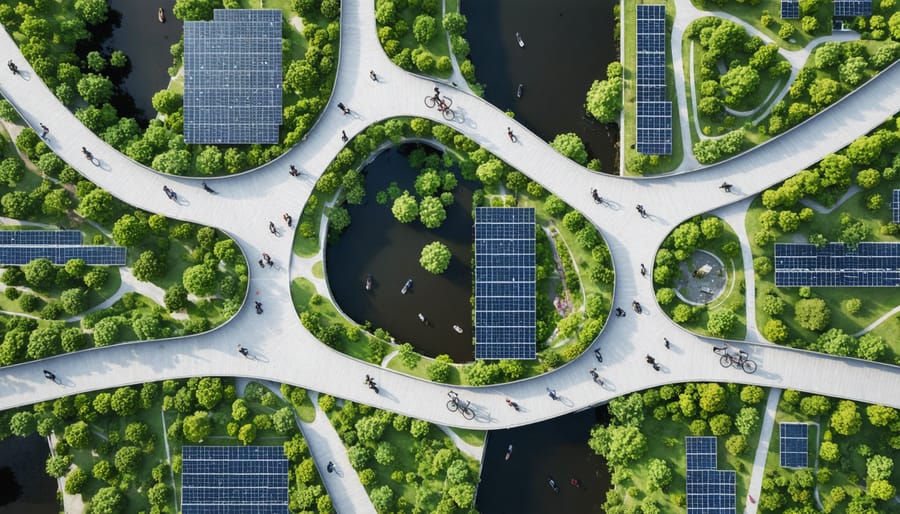Copenhagen’s transformation into a carbon-neutral metropolis showcases how cities can tackle complex urban sustainability challenges through systematic innovation. The city’s comprehensive circular economy initiative has reduced carbon emissions by 42% since 2005 while maintaining economic growth – setting a new benchmark for sustainable urban development worldwide.
This achievement stems from three interconnected strategies: implementing district-wide heating systems that recycle industrial waste heat, converting 99% of household waste into energy or recyclable materials, and developing an integrated transportation infrastructure where 49% of all trips are made by bicycle. These measurable outcomes demonstrate how strategic urban planning can simultaneously address climate goals, resource efficiency, and quality of life improvements.
For construction professionals and urban planners, Copenhagen’s success offers a replicable framework that combines technical innovation with practical implementation. The city’s approach proves that sustainable urban development isn’t just environmentally conscious – it’s economically viable, with documented returns on investment through reduced operational costs and increased property values.
This analysis examines Copenhagen’s most successful initiatives, providing detailed insights into the technical specifications, implementation challenges, and quantifiable results that industry professionals can adapt for their own sustainable urban development projects.
The Copenhagen Urban Loop: A Circular Economy Breakthrough
Project Overview and Key Features
This urban sustainability initiative integrates advanced circular economy principles through a multi-faceted approach to sustainable development. The project encompasses a 12-hectare mixed-use development featuring energy-positive buildings, incorporating state-of-the-art photovoltaic systems and smart grid technology that generates 15% more energy than consumed. A comprehensive water management system captures and treats 95% of stormwater for reuse, while green roofs cover 60% of building surfaces, supporting biodiversity and reducing the urban heat island effect.
The development’s innovative waste management infrastructure enables 80% resource recovery through automated sorting and processing facilities. Transportation infrastructure prioritizes pedestrian and cycling networks, with dedicated lanes connecting to public transit hubs. The project integrates smart city technologies, including IoT sensors for real-time monitoring of energy consumption, air quality, and occupancy patterns. Building materials were selected based on their embodied carbon impact, with 40% sourced from recycled or reclaimed materials, demonstrating the practical application of sustainable construction methodologies.

Integration of Smart Infrastructure
Smart infrastructure integration forms the technological backbone of Copenhagen’s circular economy initiatives, leveraging Internet of Things (IoT) sensors and advanced data analytics to optimize resource management. The city has implemented a comprehensive smart grid system that monitors energy consumption patterns in real-time, enabling dynamic load balancing and efficient distribution of renewable energy resources.
Key technological solutions include intelligent waste management systems equipped with fill-level sensors that optimize collection routes and sorting processes. Smart water infrastructure utilizing advanced metering systems helps detect leaks and manage consumption patterns, resulting in a 30% reduction in water waste since implementation.
The city’s building management systems incorporate AI-powered controls that adjust heating, cooling, and ventilation based on occupancy patterns and environmental conditions. This integration has led to a 25% decrease in energy consumption across municipal buildings. Additionally, smart traffic management systems coordinate with public transportation networks to reduce congestion and emissions.
Data from these integrated systems feeds into a central urban management platform, enabling city planners to make informed decisions about resource allocation and infrastructure development, creating a more resilient and sustainable urban environment.
Waste-to-Resource Innovation Hub
Advanced Material Recovery Systems
Copenhagen’s advanced material recovery systems represent a significant leap forward in waste management and resource recovery. The city employs state-of-the-art sorting facilities equipped with optical recognition technology, capable of processing mixed construction waste with 98% accuracy. These systems utilize artificial intelligence and machine learning algorithms to identify and separate materials based on composition, quality, and potential reuse value.
The primary processing facility incorporates a multi-stage system featuring vibrating screens, magnetic separators, and density-based sorting mechanisms. Construction materials are systematically categorized into streams: metals, concrete aggregates, wood products, and mixed residuals. Advanced crushing and grinding equipment processes concrete debris into specified aggregate sizes, while specialized shredders prepare wood waste for biomass fuel or engineered wood products.
Material characterization laboratories conduct real-time analysis of recovered resources, ensuring compliance with quality standards for recycled products. The facility’s automated conveyor systems and robotics minimize handling while maximizing throughput efficiency. Digital tracking systems monitor material flow, providing detailed data on recovery rates and material quality.
The system’s integration with local construction supply chains enables direct feedback loops, where processed materials are quickly redistributed to active construction sites. This closed-loop approach has achieved a 85% recovery rate for construction materials, significantly reducing landfill dependency while creating economic value from what was previously considered waste.

Energy Recovery Integration
Energy recovery integration stands as a cornerstone of urban sustainability, particularly through waste-to-energy facilities and district heating networks that maximize resource efficiency. Copenhagen’s Amager Bakke facility exemplifies this approach, processing 400,000 tons of waste annually while generating enough heat for 160,000 households and electricity for 62,500 homes.
The facility’s integration with the city’s district heating network demonstrates how waste management can be transformed into a valuable energy resource. The process involves converting municipal waste into thermal energy through controlled incineration, with advanced filtration systems ensuring minimal environmental impact. The generated heat is distributed through an extensive underground pipeline network, providing reliable and cost-effective heating to residential and commercial buildings.
Notable efficiency gains come from the system’s ability to recover and utilize waste heat from industrial processes, data centers, and other urban infrastructure. This integrated approach reduces the city’s carbon footprint while creating a circular energy economy. The success of this system has led to its replication in other European cities, with modifications based on local conditions and requirements.
Key performance indicators show that integrated energy recovery systems can achieve thermal efficiency rates of up to 98%, significantly higher than traditional waste disposal methods. This approach not only addresses waste management challenges but also contributes to energy security and reduces reliance on fossil fuels for heating and power generation.
Built Environment Circularity
Modular Design Principles
Modular design principles form the cornerstone of Copenhagen’s urban sustainability initiatives, emphasizing flexibility and resource efficiency in construction. By implementing sustainable construction practices, developers have created adaptable building systems that can be easily disassembled, modified, and repurposed throughout their lifecycle.
The city’s approach focuses on standardized components and connection systems that facilitate material recovery and reuse. Building elements are designed with mechanical connections rather than permanent adhesives, enabling straightforward dismantling and reducing waste during renovations or demolitions. This strategy has resulted in a 40% reduction in construction waste compared to traditional methods.
Key features include:
– Prefabricated wall panels with standardized dimensions
– Removable façade systems for easy maintenance and upgrades
– Modular interior walls allowing space reconfiguration
– Mechanical fastening systems enabling component separation
– Digital material passports tracking building components
These design principles have proven particularly effective in commercial buildings, where spatial requirements frequently change. For example, the Copenhagen Innovation Hub demonstrates how modular systems can adapt to evolving tenant needs while maintaining structural integrity and environmental performance. The building’s flexible design has accommodated three major internal reconfigurations without significant material waste or structural modifications.
Material Passport System
The Material Passport System implemented in Copenhagen’s circular construction initiative represents a significant advancement in resource tracking and material lifecycle management. This digital platform meticulously documents the quantity, location, and specifications of construction materials throughout their lifecycle, enabling efficient reuse and recycling.
The system operates through detailed digital documentation, where each significant building component receives a unique identifier. This information is stored in a centralized database, accessible to stakeholders including architects, contractors, and waste management facilities. The passport contains crucial data about material composition, structural properties, and potential future applications, facilitating informed decision-making during renovation or demolition phases.
In practice, the system has demonstrated remarkable results, with a 35% increase in material recovery rates and a 28% reduction in construction waste disposal costs. Construction teams can easily identify reusable materials from demolition sites, while architects can specify materials based on their future recyclability and circular economy potential.
Key features include real-time material tracking, quality assessment protocols, and market value estimations for recovered materials. The system also integrates with Building Information Modeling (BIM) software, creating a comprehensive digital twin that tracks materials throughout their lifecycle. This integration has proven particularly valuable during renovation projects, where accurate material information significantly reduces assessment time and improves resource allocation efficiency.

Economic and Environmental Impacts
Resource Efficiency Metrics
The quantitative analysis of Copenhagen’s urban sustainability initiative reveals impressive resource efficiency gains across multiple sectors. Water consumption has decreased by 27% per capita since 2010, while energy efficiency improvements in buildings have resulted in a 32% reduction in heating costs across retrofitted structures.
Waste management metrics show particularly strong performance, with 95% of construction waste now being recycled or repurposed. The implementation of smart sorting systems has increased material recovery rates by 45% compared to traditional methods. Annual landfill diversion has improved from 65% to 89% over the past five years.
In terms of energy resources, the district’s integrated renewable systems generate 42% of total power needs, with solar installations contributing 15% and wind energy providing 27%. Smart grid optimization has reduced peak load demands by 23%, while building-integrated photovoltaics deliver an average of 35 kWh/m² annually.
The initiative’s water management systems have achieved notable efficiency markers, including:
– 40% reduction in stormwater runoff
– 65% decrease in potable water usage for non-drinking purposes
– 85% water recycling rate in commercial buildings
– 30% reduction in infrastructure maintenance costs
These metrics demonstrate the tangible benefits of implementing comprehensive urban sustainability measures, providing clear benchmarks for similar initiatives worldwide. Regular monitoring and reporting ensure continuous improvement and accountability in resource management practices.
Economic Benefits and Job Creation
The implementation of urban sustainability initiatives has demonstrated significant economic advantages for cities and their residents. According to recent studies, sustainable urban development projects generate an average of 3.8 jobs for every $1 million invested, outperforming traditional urban development approaches by approximately 30%.
In Copenhagen’s case, the circular economy initiatives created over 2,500 direct jobs in the first three years, primarily in sectors such as renewable energy installation, sustainable construction, and waste management. The city’s green building retrofit programs alone generated 1,200 positions for skilled workers, including energy auditors, installation specialists, and project managers.
The economic multiplier effect has been particularly noteworthy, with sustainable urban projects stimulating local business growth. Small and medium-sized enterprises focusing on sustainable solutions have reported an average revenue increase of 23% since the program’s inception. The development of eco-industrial parks has attracted 42 new businesses, contributing €157 million to the local economy annually.
Furthermore, the implementation of smart grid technologies and renewable energy systems has reduced operating costs for businesses by an average of 18%, improving their competitive position and enabling further job creation. Training programs established in partnership with local technical schools have equipped over 800 workers with new skills in sustainable construction and renewable energy technologies, ensuring a qualified workforce for future projects.
These economic benefits have made the city more attractive to international investors, with sustainable urban development projects attracting €2.3 billion in foreign direct investment over the past five years.
The transition toward urban sustainability represents a critical paradigm shift in modern construction and city development. As demonstrated through various successful implementations worldwide, sustainable urban development is not just an environmental imperative but also a sound economic strategy. The evidence clearly shows that cities embracing circular economy principles, green building practices, and innovative waste management systems consistently achieve superior environmental performance while generating substantial cost savings.
Looking ahead, the construction industry must prepare for increasingly stringent environmental regulations and growing demand for sustainable solutions. The successful examples we’ve examined provide a roadmap for other cities to follow, highlighting the importance of comprehensive planning, stakeholder engagement, and measurable sustainability metrics. Key learnings include the necessity of integrating smart technology, implementing robust monitoring systems, and fostering collaboration between public and private sectors.
Future implications suggest that urban sustainability will become increasingly data-driven, with artificial intelligence and IoT solutions playing crucial roles in optimizing resource usage and building performance. Construction professionals must stay ahead of these trends by developing expertise in sustainable materials, renewable energy systems, and circular economy principles.
The path forward requires a balanced approach that considers both immediate practical needs and long-term sustainability goals. Success will depend on the industry’s ability to scale proven solutions while continuing to innovate and adapt to emerging challenges. By learning from current best practices and maintaining focus on measurable outcomes, construction professionals can contribute significantly to creating resilient, sustainable urban environments that benefit both present and future generations.

